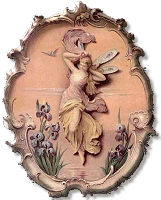
Just what we all need: another cult... The Bible-based teachings of the great patriarchy movement are not cultic enough for them... They have to prop them up with the ideology of culture, since it has more to do with culture than it does with Christianity.
They can't even come up with anything original. It's all Pre-Civil War retread.
From The Nineteenth Century "Cult of the Lady"
The nineteenth century, most of which historians have designated as the Victorian Age, was an era in which the idealization of women was developed into an art. No longer were women enjoined to simply live out their lives in dutiful labor for their families. Instead, an intricate and complicated ideology promoting the sacredness of hearth and home developed and came into its own during the years between 1830 and 1860. Women's lives for the rest of the nineteenth and on into the twentieth centuries came to be defined by and compared to this idea.
Women's fashions and the "cult of the Lady" reflected this ideology of domesticity. Although only wealthy women could aspire to be truly fashionable, the development of periodical literature which specialized in the "female concerns" of fashion, etiquette, and the home came to disseminate the current mode to an ever increasing and literate audience. Furthermore, these magazines, such as Godey's Ladies Book, presented the domestic ideal to which many aspired but only the upper and middle classes could actually attain.
Sometime during the late 1820's and early 30's, "Home" became the catchword of the day. Home became the haven from the rough world for men and children and was maintained by the smiling demure thing in spreading skirts and with folded hands. In her book on the developing technologies of housework, Ruth Schwartz Cowan remarks that the whole transition into industrialized society had a great impact upon the behavioral, moral, emotional, and political consequences of the ideology of the home. She concludes:
`Home' came to be associated with a particular sex, `women'; with a particular emotional tone, `warmth'... and with a particular form of behavior, `passivity'; while at the very same time, `work' became associated with `men', `hardheartedness', `excitement', `aggression', and `immorality.'...
...Although "cult of domesticity" is generally attributed to the Victorian era, it was no longer quite as prevalent in the years following the Civil War. Social upheaval moderated in varying degrees the adherence to the ideology. Although many women still thought of themselves as ladies, the woman of the "Gilded Age" was no longer tied to the home in the same way her sister of twenty years before was. By the late 1860's, the fashionables gave up their spreading skirts for bustles and the curiass form which delineated the female figure to a degree not seen since the 1810's.
1810's.
READ the full ARTICLE HERE.




















































